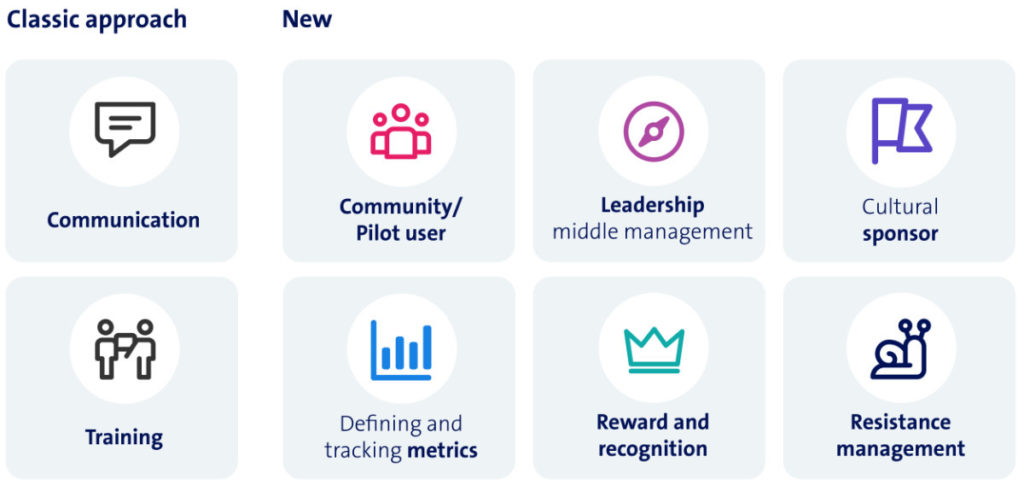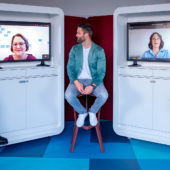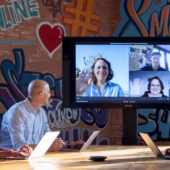Technologies are developing at breakneck speed – people, not so much. They need time to embrace change, gain knowledge and put it to good use. This creates a gap between the potential of a technology and how it’s used. Seven tried-and-tested action areas to successfully introduce modern ways of working – plus a bonus tip.
New technologies and tools enable new forms of communication and collaboration. But to achieve success, existing processes and structures need to be questioned and improved. This is why introducing new ways to work is first and foremost a matter of culture, not an IT project. Actively supporting employees is essential if a new technology is going to be used effectively in a company. Swisscom’s Future Work Experience team has developed seven action areas for successfully supporting change based on its experience introducing new communication and collaboration technologies to customers.
How can companies support employees and embed change sustainability?
The measures are vast; they are divided into three phases and require the appropriate commitment from companies. The first stage is to prepare for the change:
- What are the goals and the reasons for this change?
- Who are the target groups, and what applications do they use in their daily work?
- What effect do the changes have on other plans within the company?
- What individual measures are needed to implement the changes?
The second phase involves implementing the changes planned in the first phase. And in the final phase, these changes are embedded in the company. This task must continue to be pursued when the project is completed.
The Swisscom Future Work Experience team supports companies in these phases based on defined action areas.

Free preliminary consultation
Join us for a free conversation to discover how your company can benefit from modern working.
1. Active, regular communication
Active, regular communication about the project is key. The aim is to explain to employees why a change is needed, what needs to be achieved and how the path to success might look. Communication spans the entire course of the project and will have to start early. It raises the necessary awareness of the changes and makes people want to do more. Topics include information on the project’s status, its next steps and its vision.
Communication should not be seen as a one-way street. Change always raises questions; it can trigger fears and insecurities, but it can also generate ideas and motivation. That’s why space for feedback is needed. Group communications should be involved to ensure that necessary attention is placed on communication in the project.

A real-world example:
‘At two companies, one from the construction industry and one from the insurance industry, we as the Future Work Experience team developed a communication plan in collaboration with the project team. Our plans consider the overarching editorial planning, communication channels, target groups and project milestones. They specify who is responsible for which content and to which target groups this is communicated. The effective communication content was largely prepared within the company itself, primarily through project and group communications. We delivered content, kept track of the different target groups and their information requirements, and reviewed communication content as requested.’
2. Training and floor walking to impart knowledge
Guidance at the workplace: training and floor walking are two ways to prepare employees for new ways of working. Our training sessions are more than just an explanation of features. We show which feature makes sense and at which time, and provide background information about the project. Employees should gain an understanding of the purpose of a new tool, the opportunities it creates and how it can affect their day-to-day work. When it comes to floor walking, we use a reverse mentoring principle: Swisscom apprentices are on site at the company’s facility and visit employees at their workplace. The apprentices support, advise and guide the employees individually on all aspects of the new work methods.

A real-world example:
‘For a company in the field of quality assurance, we designed training sessions for the entire staff. They were about Microsoft 365 and Microsoft Teams. The company trained selected employees as trainers. We taught them about the features and new capabilities of the tools as well as how to support their colleagues. We held the first session, while the company carried out two more itself. What’s more, we trained the entire staff over a total of 12 training sessions in three languages.
In a hospital, we opted for floor walking. Swisscom apprentices spent several weeks in the hospital and provided individual support to the healthcare staff. Due to the daily hospital schedule, this flexibility was necessary for operational reasons. The advantage: employees were able to ask questions directly, they had one-on-one support and the floor walking fit perfectly into their daily routine.’
3. Building community
The aim here is to get a group of employees to embrace the changes. This group should be reflective of the organisation, i.e. include employees from as many areas and hierarchical levels as possible. The community gets an in-depth view into the new developments. This allows members to familiarise themselves with the features and understand the impact a new tool will have on communication and collaboration. These employees know why the changes are necessary and what they are intended to achieve. They’re fans. They want to improve the company and support their colleagues in the process.
The community members are their colleagues’ first point of contact:. not only for the features of a new tool, but also for the changes that a new tool signifies for the approach to daily work on a basis. It is important that the community members are given time and responsibility and are also allowed to carry out their duties. They need the legitimacy of the organisation, both during and after the project, because the community should continue to be active afterwards. The community is a place for discussing and evaluating ideas. Employees can support each other, which relieves the workload on the service desk. Since a community has to be supported, active community management in the company is crucial.

A real-world example:
‘A company in the construction industry created a power user community of approximately five percent of its staff. These employees participated in the Microsoft Teams pilot and played a key role in determining how the tool was to be used in the organisation. The community was established around six months before the go-live and embedded in the pilot. Weekly discussions took place between the project team and the community. Concrete points were developed, tested and defined in collaboration.
When Microsoft Teams went live throughout the entire organisation, the community opened to all employees. It now serves as a place for dialogue, to communicate changes and innovations, and to introduce ideas. The community is not limited to Microsoft 365 or Microsoft Teams, but also addresses matters of communication and collaboration.’
4. A cultural sponsor provides essential support
Introducing a collaboration tool or a new ERP system is a major project. That’s why such projects need a sponsor. This person has to be active, visible and communicative – formally and informally. This type of sponsorship has an immense impact on the success of the project. A sponsor must be able to dedicate the necessary time to these tasks. The project team must closely accompany and involve this person, especially when making important decisions. After all, the sponsor could, for instance, represent these decisions on the management board. This requires a personality with appeal and influence in the company.

A real-world example:
‘At a company in the field of quality assurance, a member of the management team took on the role of cultural sponsor. This person also commissioned the project to introduce Microsoft 365 and Microsoft Teams and had the necessary influence as a member of the Executive Board. He was aware that corporate culture is crucial to the success of such a project.
The sponsor performed his role in Executive Board meetings and in providing information to employees. He was present, provided input from the project team and raised objections. The sponsor was also the person who held dialogues with the biggest critics and received their input. The project team and Swisscom provided the necessary information in a format that could be used directly. The project team ensured close coordination between all parties involved.’
5. Leadership for the project
In addition to the community, managers at all levels are a key target group when it comes to implementing change. Managers such as team leaders are close to employees and relay the management’s messages. They also understand the individual needs of their employees. Therefore, it is critical that managers support a project. For this to happen, they need to recognise the positive aspects of the project and the changes it will bring. To achieve this, managers must be involved at an early stage, receive background information, give feedback and know in advance what the next steps are. This gives them enough time to prepare the teams for the changes. Managers are the coaches of their employees; they support them individually when changes occur and deal with the resistance.

A real-world example:
‘A roadshow brought the executives of an insurance company on board. In two-hour sessions, they were shown the added value the project would create for them and their employees, the changes it would trigger and how the employees would be supported. Potential resistance by employees was also discussed, and managers were also given the chance to express their reservations. Managers also received a live demo of Microsoft Teams so they could get an idea of the new environment and get excited. The roadshow was conducted by a team from the company. The project team and the cultural sponsor facilitated the sessions. We helped set up the roadshow and develop the content.
A company from the construction industry held this type of roadshow virtually. Managers were able to ask questions, enquire about background information in more detail and prepare for the changes to the daily work routine. Participants were encouraged to exchange ideas with the power users so that their knowledge could be incorporated into the management’s considerations. After the go-live, managers were offered consultation hours moderated by the project team.’
6. Managing resistance
Resistance arises in every project, regardless of how good the project or change management is. It is a natural response and is important. Resistance is an indicator of anxiety amongst employees. Recognizing it is essential, as this resistance can prevent changes from being accepted later. Resistance can also reveal the project team’s blind spots.
Before starting the project, it is important to know the company’s stakeholder groups. What are their biggest grievances on a daily basis where collaboration is concerned? How do they currently work? What do they absolutely want to retain? Ignoring an important stakeholder group that is also critical of the project and has a major influence can negatively influence the project. The aim is not to eliminate resistance, but to mitigate it. This is where the managers and the sponsor come into play again.

A real-world example:
‘We carried out a comprehensive persona analysis for a financial company. We interviewed around 50 employees on the topics of communication, collaboration, mobile working, security, potential for optimisation and knowledge management. This analysis revealed the challenges the employees face. In particular, fears and uncertainties became apparent, which gave indications of potential resistance. This knowledge now enables the project team to address specific resistance directly and keep an eye on resistance that is less concrete. Thanks to the awareness and analysis of potential resistance, we were able to develop scenarios for how to deal with it.’
7. Measuring performance
Are the support measures for the project effective? Do employees feel well informed? We often have a gut feeling about such questions, but we don’t have specific answers. Key figures are needed to measure the success of the support a project receives. Suitable performance indicators could include, for example, employee satisfaction with the support measures or confidence in the new work methods. The results indicate whether measures need to be adapted. The key figures should be determined early on so that a baseline measurement is possible.

A real-world example:
‘We performed a baseline analysis with an insurance company and asked questions that served as our baseline measurement for the established key figures. For example, we surveyed their satisfaction with current work methods. And we investigated how often which work methods were used to what end. We were then able to compare the results of this baseline measurement with the results of a second measurement, which took place six months later.
At the same time, we wanted to know how satisfied employees were with the support measures. To find out, we regularly asked how well the employees were being supported and how confident they felt with the new work methods. For example, we asked them to assess communication, the training sessions, the learning content and how accessible they were. This information helped us to make early and regular adjustments to the project.’
8. Bonus action area: reward and recognition
A large project has many milestones. These should be celebrated, no matter their size. It is a way to express appreciation. These ‘celebrations’ highlight what has already been achieved. And they serve as motivation for the next steps. The rule is: there’s always an occasion for a small aperitif or a mid-morning snack, even if the project to-do list seems endless.
What steps do I really need to take as a company?
There are many action areas that need to be considered. Which ones are really relevant for you and your project and how comprehensive should the support be? To find out whether advice and support can help you in your company, ask yourself the following:
- Does my project influence processes, communication or collaboration?
- Does the success of the project also alter the way employees work?
If you answer ‘yes’ to these questions, it is important to support your project with change management. It will take a joint effort to determine the scope of the support you need. The Swisscom Future Work Experience team will be happy to assist you. Sign up for a free, non-binding consultation.





